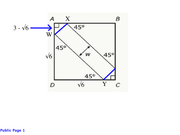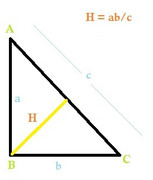Also, you can solve this problem by just looking at the picture, estimating the length, and estimating the answer choices.
The picture is accurate, so we can estimate visually. Given that AB = 3, a quick glance makes it clear that w is 1 or less.
mevicks wrote:A) 3√2 - 2√3
Approximately 3(1.4) - 2(1.7).
Approximately 4.2 - 3.4.
Approximately 0.8.
Pretty good.
B) 3√2 - √6
Approximately 4.2 - (something about halfway between 1 and 2).
Whoa! Way way way too big.
C) √2
About 1.4.
Way too big.
(D) 3√2/2
Approximately one and a half times 1.4.
More than 2!
Way way way too big.
E) 2√3 - √6
Approximately 2(1.7) - (something about halfway between 1 and 2).
Approximately 3.4 - (something about halfway between 1 and 2).
Almost 2!
Way way way too big.
A is the only choice that's even halfway reasonable. If you figure out about how big the other four choices are, they're all ridiculous.
Ron has been teaching various standardized tests for 20 years.
--
Pueden hacerle preguntas a Ron en castellano
Potete chiedere domande a Ron in italiano
On peut poser des questions à Ron en français
Voit esittää kysymyksiä Ron:lle myös suomeksi
--
Quand on se sent bien dans un vêtement, tout peut arriver. Un bon vêtement, c'est un passeport pour le bonheur.
Yves Saint-Laurent
--
Learn more about ron























